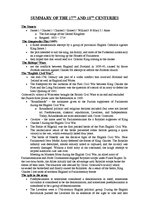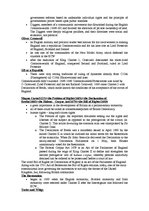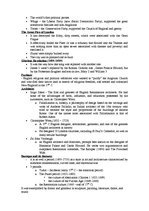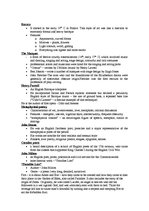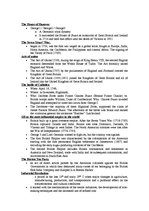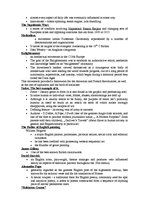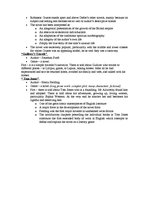-
Summary of the 17th and 18th Centuries (in Britain)
The Stuarts
• James1 / Charles1 / Charles2 / James2 / William3 & Mary 2 / Anne
o The first kings of the United Kingdom
o Reigned: 1603 – 1714
The Gunpowder Plot (1605)
• a failed assassination attempt by a group of provincial English Catholics against King James 1
• the plot intended to kill the king, his family, and most of the Protestant aristocracy an a single attack by blowing up the Houses of Parliament
• they hoped that this would lead to a Catholic King coming to the throne
The Bishops' Wars
• are the conflicts between England and Scotland in 1639-40, caused by fierce Scottish reaction against Charles It's attempt to reform the Scottish church.
The "English Civil War"
• the mid-17th Century was part of a wider conflict that involved Scotland and Ireland as well as England and Wales.
• The flashpoint for the outbreak of the First Civil War between King Charles the First and the Long Parliament was the question of control of an army to defeat the Irish Uprising of 1641.
Cromwell's victory at Worcester brought the British Civil Wars to an end and excluded the Stuarts from power until the Restoration in 1660.
• "Roundheads" – the nickname given to the Puritan supporters of Parliament during the English Civil War.
o Roundhead political and religious factions included (but were not limited to) Presbyterians, classical republicans, Levellers, and Independents. Today, Roundheads are most associated with Oliver Cromwell.
• Cavalier – the name used by Parliamentarians for a Royalist supporter of King Charles I during the English Civil War.
• The Battle of Edgehill was the first pitched battle of the First English Civil War. The inconclusive result of the battle prevented either faction gaining a quick victory in the war, which eventually lasted four years.
• The battle of Naseby was the decisive fight of the English Civil War. Here Parliament's New Model Army defeated the forces of King Charles. The Royalist infantry was destroyed, almost entirely killed or captured, and the cavalry was severely damaged. Without a field army at his command, the king's attempt to impose autocratic rule was over.
Meeting on Marston Moor during the English Civil War, an allied army of Parliamentarians and Scots Covenanters engaged Royalist troops under Prince Rupert. In the two-hour battle, the Allies initially had the advantage until Royalist troops broke the center of their lines. The situation was rescued by Oliver Cromwell's cavalry which traversed the battlefield and finally routed the Royalists. As a result of the battle, King Charles I lost most of northern England to Parliamentary forces
The split in the army.
…
konspekts ir veidots, gatavojoties eksāmenam par angliski runājošo valstu vēsturi, izglītību, kultūru un literatūru. Apskatīts 17. un 18. gadsimts un būtiskākie notikumi politikā, sabiedrībā, kultūrā, kā arī literārie darbi un to autori.

